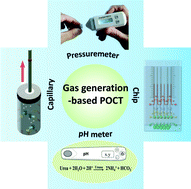Gas-generating reactions for point-of-care testing
Abstract
Gas generation-based measurement is an attractive alternative approach for POC (Point-of-care) testing, which relies on the amount of generated gas to detect the corresponding target concentrations. In gas generation-based POC testing, the integration of a target recognition component and a catalyzed gas-generating reaction initiated by the target introduction can lead to greatly amplified signals, which can be highly sensitive measured via distance readout or simple hand-held devices. More importantly, numerous gas-generating reactions are environment-friendly since their products such as oxygen and nitrogen are nontoxic and odourless, which makes gas generation-based POC testing safe and secure for inexperienced staff. Researchers have demonstrated that gas generation-based measurements enable the rapid and highly sensitive POC detection of a variety of analytes. In this review, we focus on the recent developments in gas generation-based POC testing systems. The common types of gas-generating reactions are first listed and the translation of gas signals to different signal readouts for POC testing are then summarized, including distance readouts and hand-held devices. Moreover, we introduce gas bubbles as actuators to power microfluidic devices. We finally provide the applications and future perspective of gas generation-based POC testing systems.

- This article is part of the themed collection: Recent Review Articles


 Please wait while we load your content...
Please wait while we load your content...